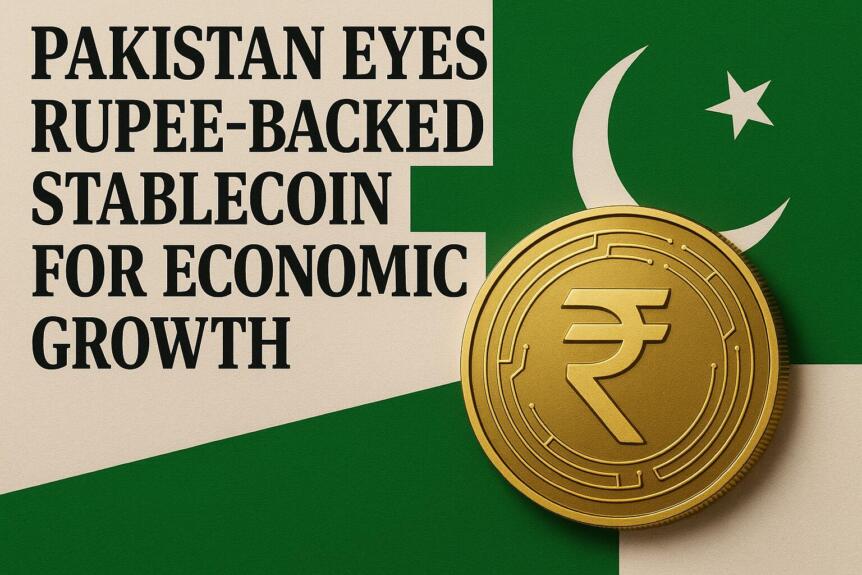Pakistan Eyes Rupee-Backed Stablecoin for Economic Growth

Key Insights:
- Pakistan aims to launch a rupee-backed stablecoin to improve financial inclusion.
- ZAR’s successful funding round underscores the growing fintech sector in Pakistan.
- Pakistan has become one of the most active cryptocurrency markets.
Pakistan is currently trying to implement a rupee-based stablecoin to propel its financial system. This is a step taken by the country as part of its efforts to take advantage of the rising cryptocurrency market. Pakistan stands to lose an economic potential worth of 2025 billion dollars due to concerns that it is taking too long to develop a regulatory framework to regulate the digital assets.
The Stablecoin Opportunity
Zafar Masud, the President of Pakistan Banks Association (PBA), has pointed out the potential financial growth that digital assets have at the Sustainable Development Policy Institute (SDPI) Conference. He highlighted the opportunities of a stable coin, which is supported by rupee, to make financial access more feasible and minimize the remittance expenses. Being a fast developing market, global stablecoins are perceived as one of the opportunities that Pakistan is to consider.
According to Faisal Mazhar, the Deputy Director of Payments at the State Bank of Pakistan, there is already a prototype of Central Bank Digital Currency (CBDC). The project is underway with a pilot phase with the support of the World Bank and the International Monetary Fund (IMF). The actual rollout will be done when the system is properly tested and refined.
ZAR’s Vision for Financial Inclusion
ZAR, a financial technology company, has just received a 12.9 million round of funding by Andreessen Horowitz (a16z). The other investors are Dragonfly Capital, VanEck Ventures and Coinbase Ventures. ZAR seeks to implement dollar-backed stablecoins among the huge population of the unbanked in Pakistan. The population of Pakistan has more than 240 million with more than 100 million adults having no access to traditional banking. ZAR sees this as a chance to close the divide of financial inclusion.
This is part of the greater vision of Pakistan to adopt digital assets. Chainalysis 2025 Global Crypto Adoption Index showed that Pakistan has risen to the third place as one of the fastest-growing cryptocurrency markets in the world. It is also working hard to attract foreign investment, meaning it is opening its doors to international crypto exchanges and Virtual Asset Service Providers (VASPs) to obtain local licenses.
Pakistan’s Regulatory Framework: A Step Towards Progress
Recently, the cryptocurrency space in Pakistan was regulated by the creation of a new blockbuster called the Pakistan Virtual Asset Regulatory Authority (PVARA). This authority is mandated with the responsibility of licensing and overseeing VASPs. By the new framework, Pakistan aims at formalizing and enhancing its digital asset industry.
The invitation to international crypto companies to send Expressions of Interest (EoIs) made by PVARA is an important measure in ensuring that the environment is amenable to international players. The nation is preconditioning the increased use of crypto. Pakistan is optimistic that by instituting a proper regulatory framework, it will eventually become innovative and be able to attract foreign investment.
Stablecoins and the Future of Pakistan’s Crypto Economy
The push toward a stablecoin pegged against the rupee is an indicator of the desire of Pakistan to have a modernized financial system. Being a constituent of the new global crypto economy, the rupee-based stablecoin may be taken as a new route through which the nation can achieve economic growth. In the meantime, the partnership of Pakistan with international companies and financial institutions puts emphasis on the increasing possibilities of blockchain technology and stablecoins in the emerging markets.
This article was originally published as Pakistan Eyes Rupee-Backed Stablecoin for Economic Growth on Crypto Breaking News – your trusted source for crypto news, Bitcoin news, and blockchain updates.
También te puede interesar

Crucial US Stock Market Update: What Wednesday’s Mixed Close Reveals

Trump will host a dinner for business leaders at the White House at 8:30 a.m. tomorrow.
